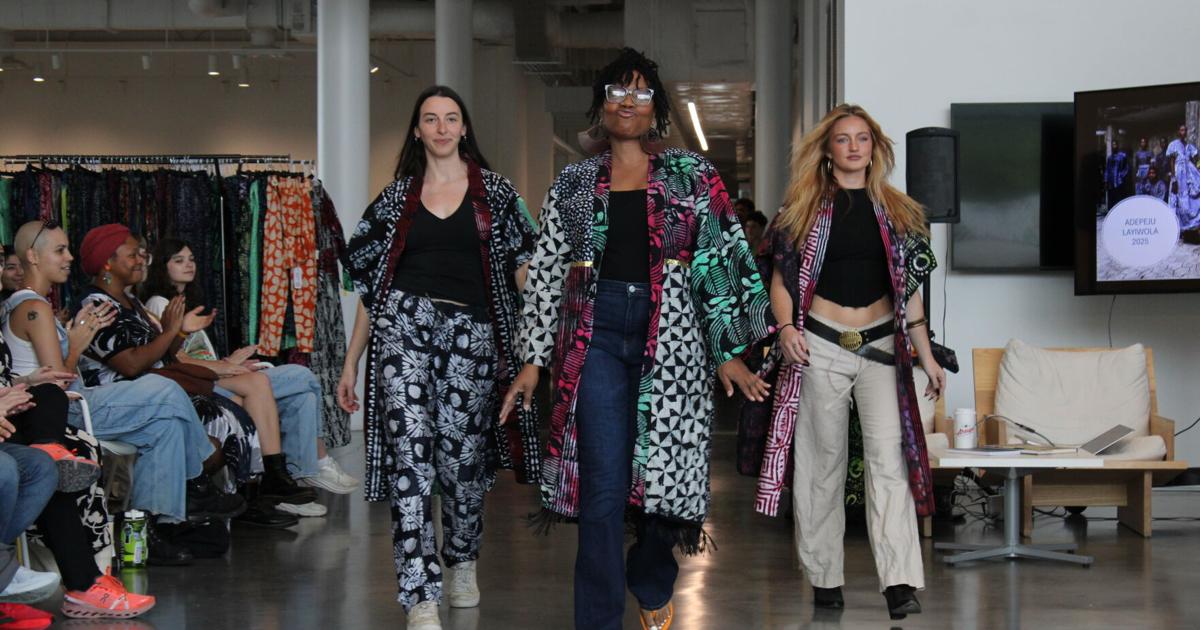Across the University of Arkansas, a bright cardinal red can be seen on signs, banners and posters. But, on Sept. 25, the campus’s Studio and Design center filled with deep and vibrant colors – more than just red.
“Let us Dye Together,” a fashion show that taught more than just the process of dyeing cloth, took over the studio and design centers’ lobby. Students celebrated tradition and culture while working together to light up the runway.
The fashion show was a collaborative project hosted by Kathy Brown, who is an endowed assistant professor in art education, and Janine Sytsma, a professor specializing in contemporary global African Arts.
Student volunteers modeled clothes created by guest speaker Peju Layiwola, a UA graduate, and student Edward Berchie Osei.
Leading up to the event, Layiwola hosted a week-long workshop focused on teaching cultural textile traditions. Students from Sytsma’s art history and Brown’s art education classes used dyes, wax and cassava starch to create their own Yoruba textiles.
Yoruba textile work is a type of fabric creation mainly passed down from mother to daughter. It originates in Southwest Nigeria and is practiced by the Yoruba people. Layiwola describes the textile creation as organic.
“Females in southwestern Nigeria, Yoruba women, they devised this method of using cassava starch to create resistance on cloth, and they dyed it with indigo,” Layiwola said.
Specifically in Nigeria, pieces of fabric are woven together, dyed and stamped to be worn. Layiwola said she believes the creation of the fabric does not stop at just clothing.
“Cloth is a major part of their identity, the Yoruba people; they love to dress well,” Layiwola said. “But it is more than just cloth, it is something that is so close to your skin that it is an extension of the body.”
Layiwola said she was proud of the work the students created. Students used reverse dying techniques to create patterns on T-shirts, tote bags and scrap pieces of fabric in the studio.
“They produced incredible work, the T-shirts that they made and the tote bags that were also made were really beautiful,” Layiwola said.
Volunteer students arranged the Studio and Design lobby to mimic a fashion runway. A television screen projected examples of Yoruba textile work while African music played in the background.
Displayed above the runway was an original textile handmade by Yoruba Nigerian women on loan from the UofA Museum’s private collection, off campus.
Brown, whose students participated in the workshop, said she could not be prouder.
“This has been a wonderful experience for all of our students,” Brown said. “It was important for my students to be able to immerse [themselves].”
Sytsma’s students enrolled in her African art and society class also joined the workshop. These students, who do not usually get to participate in hands-on activities in class, were able to use their creativity, she said.
“It was really wonderful to integrate this practice into an art history class because usually you do not get to work with your hands in art history,” Sytsma said.
Brown also said it is vital for students to become hands-on in class. She believes such experiences for art history students are important to expand their theory of knowledge.
“It shapes your paradigm when you are able to not just write about it and see it but do it,” Brown said. “This was an important experience, and I think all the students had salient takeaways that they can use in many, many, many different facets in their own practice.”
One of Brown’s students, Osei, also had Yoruba-inspired clothes displayed in the fashion show. Osei is originally from Ghana and has lived in Fayetteville for over a year while working toward his graduate degree in art education.
Growing up, Osei taught himself to use a sewing machine and mend clothes, eventually sewing and making textiles. He uses materials such as Ankara, an African fabric, non-toxic dye and denim.
Osei said he sees sewing as therapeutic and uses it to keep himself disciplined. He believes his artwork displays a positive message and that his motivation is to spread positivity to his audience.
“Right now I am beginning to see fashion, tailoring and sewing as a way of staying mindful,” Osei said. “I’m the kind of person where I love to see all people excited. I don’t do white, I don’t do black, I don’t do brown. I see people to be people. That’s me. It’s not because I’m coming from the other side [Nigeria], but that’s how I grew up. So I feel like my greatest inspiration all the time is how can I make people happy? How can I use my craft to make people feel loved?”
In fall 2024, Osei started his “Stitch and Style” workshop. Stitch and Style is an open-studio class where individuals can learn how to sew their own clothes. This year, starting in October, Osei will implement dying garments into his mending workshop. He encourages anyone to participate.
“We feel and believe this is a space where nobody is judged, whatever you do is not wrong, whoever you are does not matter, just come work and get some skill,” Osei said.
link

